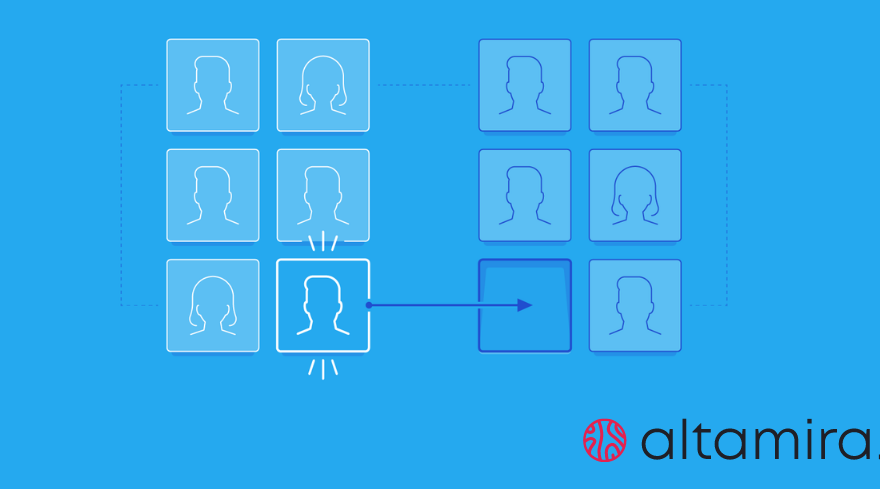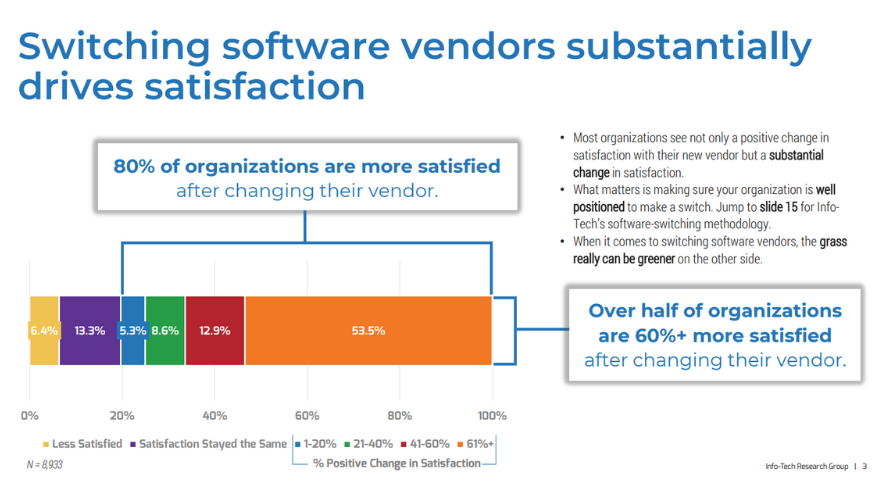Table of Contents
As a business owner, at any stage of outsourcing project development, you may face project stagnation, demotivation of the team, and lack of agility and growth. These signals demonstrate the urgent need to take measures and pass the project to another outsourcing vendor. It may be costly and harsh unless you take the appropriate precautionary steps to make it smooth and downtime-free.
Is the grass greener on the other side? Why you should consider changing software development teams
Source
Letting the previous vendor go is always a far better option than developing a Stockholm syndrome with your vendor and risking the progress of your software, as the statistics shows that over a half of organizations are 60%+ more satisfied after changing the previous software provider.
The change of the software development team will be successful if you plan the project transition thoroughly, taking into account the risks and organizing all the crucial processes properly. Primarily, you will have to take care of the onboarding of the newcomers and the development team, who will be responsible for the legacy code review.
The new outsourcing vendor expects a clear definition of the project details from you, so the new team can understand how you work and automate processes. In case the knowledge transfer does not occur, disagreements may arise. The fear of risking switching your software project to another vendor may be dispelled by accurate planning.
Is changing the software supplier worth time, risks, and resources?
You need to understand that switching suppliers may be costly and disruptive to business processes. Thus, while deciding to change vendors, it is necessary to evaluate the value that a potential vendor will bring, the challenges and risks, and the cost of the whole procedure.
Possible value a new supplier can bring:
- Assist in moving to the next growth stage;
- Offer superior options, including more efficient technologies, instruments, and methods.;
- Deliver on contractual commitments, providing even more value to the project than expected.
Apart from the benefits and values, you can get while switching the suppliers at a short notice, you should also consider the possible challenges and risks.
Challenges and risks you may face when you move a project to a new outsourcing partner
Outsourcing itself may pose some risks for business, and switching the outsourcing partners can double these risks. However, knowledge is the weapon. The awareness allows a business owner to mitigate the possible risks and easily overcome the potential challenges.
- As a customer, you will have more difficulty describing the services in its Request for Proposals (“RFP”) or Statement of Work (“SOW”);
- Lack of transferable function, since the previous vendor has likely folded the customer’s internal function into a shared service environment that the customer cannot provide to the new supplier;
- Difficulties with a knowledge transfer;
- Problems with the termination of the existing relationships may result in additional expenses and delays.
It is necessary to accurately plan knowledge transfer and organizational procedures to make the transition smooth and avoid the above-mentioned challenges.
Key steps to take when you move a project to a new outsourcing partner
Thorough planning will make the transition quick and smooth and mitigate all the above-mentioned risks. The planning procedure involves the following actions:
- Determine the date, when the new team takes over the responsibilities for the project
- Plan the overlap period, when previous and new team members will work on knowledge transfer, making sure all are contributing to the success of the transition;
- Ask the legal staff to analyze when it is better to give the termination notice, after finishing the previous two steps. Giving the termination notice following the current agreement within the required period is critical to terminating the existing arrangement as expected.
- Revise the NDA (non-disclosure agreement), if any confidentiality restrictions may be disclosed to prospective software development teams
- Organize the cooperation between the new development team and previous vendors for a more efficient transition.
- Determine if there are any employees of the current supplier (or its subcontractors) that it would like the new supplier to hire.
- Take care of transferring leases, licenses, and other contracts, ensuring all the documents are in full force and effect, with no defaults and no outstanding amounts.
- Ask the current team to prepare a knowledge transfer plan for the in-time transition of knowledge, including the info about the responsibilities of the current supplier, tasks for a new team, applicable milestones, and completion dates.
Effective knowledge transfer plan – the core necessity
It is crucial to take care of knowledge transfer plans for entrepreneurs who are willing to change software developers’ teams quickly and efficiently. To be brief, it is a plan that allows to pass all the information, written or oral, from the previous software engineering team, which was working on the project, to a new one. Why is it so important? Because it contains explicit knowledge of the project, crucial details, the team’s knowledge, ideas, plans, details concerning the tech stack used, etc.
Below, you can see the scheme reflecting the complexity of the knowledge transfer process.
Since the transfer process is multi-layered, the compilation of the proper transferring knowledge plan may turn quite challenging. Thus, we will dwell on the efficient knowledge transfer methods that will make the software development process easier for a new development team. Moreover, it will cut the unplanned expenses and make the development flow smooth and stable.
Knowledge transfers fail when it is chaotic and unstructured. However, the successful result of the transition also depends on the customer, the previous team, and the new vendor. All parties involved should put considerable effort into maintaining a smooth transition. Letting the previous vendor go is always a far better option than developing a Stockholm syndrome with your vendor and risking the progress of your software.
Additional issues you have to encounter to change software vendors successfully
Primarily, you need to understand that building relationships with the new team on transparency and a shared vision of the strategy. You need to test the potential vendor against the challenges you have faced before and discuss their approach to work, strategies, and the vision of the whole process.
The next step will be solving the documentation issues. You will need to provide all sufficient information on the project and documentation. The process may be time-consuming, but you need to gather all the necessary items, including:
- App’s architecture details;
- System configuration guidelines, operating instructions, list of files with bug details;
- List of packages necessary for the establishment of the environment;
- Description of the critical algorithms;
- Database description details;
- Source code deployment details and guidelines.
Approach, experience, and responsibilities transfer
Apart from document and knowledge transfer, you need to transfer the approach, experience, and responsibilities necessary for maintaining the system during the project lifecycle. The new team should get a general idea of the product and understand the possible risks and challenges since these areas are the core ones for resultful cooperation. Here are these key areas to take into account:
- The general concept of the product (the goal of the project, product value, details about the end-users, and core features).
- Work outline (development roadmap, current status, the scope of remaining work that should be done).
- Challenges (challenges that were previously faced as well as efficient strategies to address them successfully, discuss the transition challenges and way to overcome possible obstacles).
- Workflow management (roles, responsibilities, duties, communication tools, and task management instruments).
Code review
The project transfer is impossible without the code review. For measuring the technical debt it is necessary to conduct a code audit. It will also allow to access the general health of the app and define the new team’s capabilities to handle it.
The analysis of the code enables the implementation of new features quicker, reducing the costs spent. Code review triggers objective feedback, risk evaluation, and a rescue plan in case of necessity.
Transfer software project easily and successfully to a reliable partner
Altamira experts will likely find the best practices for your individual case, facilitating the smooth and successful transfer of suppliers, and being oriented on your individual business requirements. We offer advanced help in switching outsourcing vendors based on our in-depth expertise. Understanding the possible risks and goals related to the transition, we put our efforts to build trust with customers and increase business performance.
The transfer to another outsourcing vendor is a daunting process that may raise many issues, like:
- Will the transition process pay off?
- How to ensure the new vendor de-risk the transition and deliver the expected quality of service?
- How to motivate the previous vendor to support the process of transition?
In case you have decided to change the software engineers team midway through a strategic project, you may face many implications. Those may include increased costs, and delayed outputs. We know how to handle it with effective knowledge transfer methods going through all the key steps for a successful project transition.
How we will help in project transition success?
We guarantee the full project transition on an individual, team, and organizational level.
- Through our knowledge transfer flows, the analytics team analyzes the available documentation and penetrates deeply into the business side of the project.
- Agile software development techniques allow to quickly onboard the new team and start demonstrating positive dynamics within the shortest terms.
- The key to any transition is a good project manager who can ensure the plan is laid out clearly and then proactively manages the change.
- The system architect and senior developer work on technical implementation details. Analyze the code written, and identify the key algorithms specification and implementation of new technologies to show the best results.
- The delivery manager guarantees the services will be seamlessly delivered.
- QA engineers make sure that the version of the application received after building the code from the sources is the same as the version the customer has paid for to the vendor.
- The designer checks whether all the design, graphics user stories, and knowledge items are transferred in appropriate formats for work in the future.
Wrapping up
Having the plan in place helps outline key team members’ responsibilities and checkpoints for both the offshore team and the current internal (or consulting) team. In case, you experience project stagnation, lack of motivation inside the team, and unplanned expenses, it is time to consider the change of software vendor. The best guarantee of software vendor transition success is a solid transition plan and planning of the actions that should be taken. With Altamira. you will have a guarantee of smooth vendor transition and efficient future cooperation.








